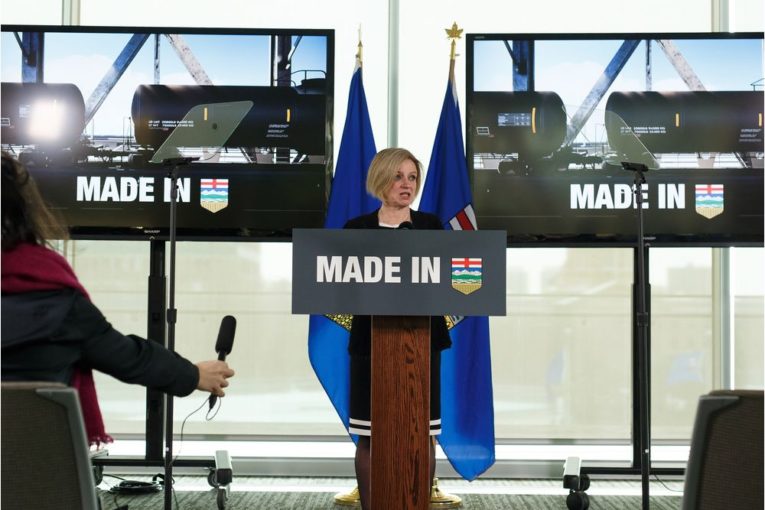
Alberta is making a costly bet on trains to help fix the province’s oil-transportation bottleneck.
And like a frustrated passenger standing on the platform, it’s not waiting any longer for Ottawa to climb aboard its rail plan.
Premier Rachel Notley announced Tuesday her government has reached agreements with Canadian National Railway and Canadian Pacific Railway that will allow the province to increase the movement of crude by rail from Alberta.
The province has decided to lease about 4,400 rail cars, allowing it to ship an additional 120,000 barrels of oil per day out of Alberta by next year.
For a province lacking enough pipeline capacity to transport all of its petroleum production, it’s a big-ticket wager.
The total investment is pegged at $3.7 billion over three years, not exactly chump change for a province wrestling with a massive deficit.
The government projects the plan should generate $5.9 billion in increased oil royalties, taxes and commercial revenue over those three years — ultimately providing the province with a $2.2-billion profit.
“This is something that is fundamentally important to improving the return that all Albertans get on our important energy resources,” Notley told reporters in Edmonton.
The key component for the government is increasing the amount of oil that can be moved out of the province, to help prevent another costly blowout in the price differential between benchmark U.S. crude and Western Canadian Select heavy oil.
Due to growing oilsands output, a lack of transportation capacity and Canada’s continued inability to build new pipelines, the price discount on Western Canadian Select soared above US$50 a barrel last fall.
At one point, the quagmire was costing the country’s economy an estimated $80 million a day.
To fix the short-term issue of oil being sold at deeply distressed prices, the province ordered producers to temporarily cut output this year. The differential has since diminished, closing at $14.50 a barrel on Tuesday, according to Net Energy.
But it’s not sustainable to curb production for long. Building pipelines is the ultimate solution.
While Enbridge’s Line 3 replacement project is expected to begin operating later this year, it will soon fill up.
Meanwhile, the timing is uncertain for the larger Trans Mountain pipeline expansion and Keystone XL project.
Rail will play an important role as an intermediate solution, even though it is more costly and not as safe as shipping oil through pipelines.
With Alberta’s rail plan, the province says new capacity will begin to come on line as early as July, ramping up by the middle of next year.
Provincial officials estimate the new program should shrink the oil-price differential by about US$4 per barrel.
Under the program, Alberta will buy oil from producers and use rail-loading facilities in the province to ship it to other markets, potentially international and U.S. customers on the Gulf Coast.
“Until we get a resolution to the pipeline issue, rail is going to continue to be a major player in clearing the basin,” said John Rogers, a vice-president with MEG Energy, a mid-sized oilsands producer that currently moves about 20,000 bpd by rail.
“What it will do for MEG is help to ensure the pricing that we receive for our product — and Alberta receives for its product — is the best pricing that can be obtained.”
Rogers noted demand for heavy oil in North America has never been greater than it is today, as production in Venezuela is dropping and U.S. refiners are paying a premium for heavy crude.
All this begs the question, why does the government need to get involved?
United Conservative Party Leader Jason Kenney pointed out the plan may drive up costs for the private sector to contract out more rail capacity in the future.
“It moves risks and costs from the private sector onto the backs of taxpayers,” he told reporters.
No one wants to see public money used to resolve private-sector problems, but there are several key factors to consider.
For one, producers have been reluctant to make long-term rail commitments given the expectation — and Ottawa’s own insistence — that oil pipelines would eventually be built.
As well, smaller and mid-sized producers often lack the financial capacity to put together transportation deals involving rail, and some will use the province’s program, said Tristan Goodman, head of the Explorers and Producers Association of Canada.
“If you had a perfectly functioning free market and didn’t have the issues of pipeline approval that we currently have, I don’t think we would need this,” Goodman added.
The rail program will also help assure investors that Alberta oil producers will be able to move their crude to market.
“The Alberta government has chipped in . . . due to a situation that is really extraordinary,” said industry analyst Kevin Birn of consultancy IHS Energy.
“But they’re only part of the solution. There is significant volumes of rail capacity needed to be taken by private companies.”
All of the recent government intervention in the energy sector — from Ottawa’s $4.5-billion purchase of the Trans Mountain pipeline to curtailment to Alberta’s rail program — comes at a steep price.
And Alberta still has no assurance the feds will help with funding the rail-car program, almost four months after making its initial pitch to the Trudeau government.
“There comes a time where debating the number of angels on a pin with the federal government is not of value,” Notley said.
“We’re going to go ahead.”
Like last year’s Trans Mountain purchase, this is an expensive decision designed to address another symptom of Canada’s underlying energy malaise, rather than the root cause.
But until the real problem is resolved — building new pipelines — a temporary fix is better than no fix at all.
Chris Varcoe is a Calgary Herald columnist.
You can read more of the news on source
